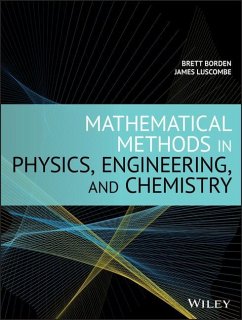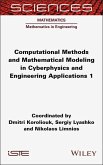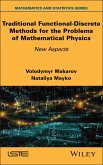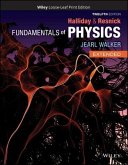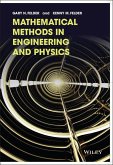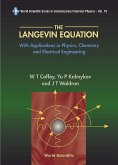- Gebundenes Buch
- Merkliste
- Auf die Merkliste
- Bewerten Bewerten
- Teilen
- Produkt teilen
- Produkterinnerung
- Produkterinnerung
A CONCISE AND UP-TO-DATE INTRODUCTION TO MATHEMATICAL METHODS FOR STUDENTS IN THE PHYSICAL SCIENCES Mathematical Methods in Physics, Engineering, and Chemistry offers an introduction to the most important methods of theoretical physics. Written by two physics professors with years of experience, the text puts the focus on the essential math topics that the majority of physical science students require in the course of their studies. This concise text also contains worked examples that clearly illustrate the mathematical concepts presented and shows how they apply to physical problems. This…mehr
Andere Kunden interessierten sich auch für
![Handbook of Measurement in Science and Engineering, Volume 3 Handbook of Measurement in Science and Engineering, Volume 3]() Handbook of Measurement in Science and Engineering, Volume 3360,99 €
Handbook of Measurement in Science and Engineering, Volume 3360,99 €![Computational Methods and Mathematical Modeling in Cyberphysics and Engineering Applications 1 Computational Methods and Mathematical Modeling in Cyberphysics and Engineering Applications 1]() Computational Methods and Mathematical Modeling in Cyberphysics and Engineering Applications 1152,99 €
Computational Methods and Mathematical Modeling in Cyberphysics and Engineering Applications 1152,99 €![Traditional Functional-Discrete Methods for the Problems of Mathematical Physics Traditional Functional-Discrete Methods for the Problems of Mathematical Physics]() Traditional Functional-Discrete Methods for the Problems of Mathematical Physics152,99 €
Traditional Functional-Discrete Methods for the Problems of Mathematical Physics152,99 €![Proceedings of the Conference in Honor of C N Yang's 85th Birthday: Statistical Physics, High Energy, Condensed Matter and Mathematical Physics Proceedings of the Conference in Honor of C N Yang's 85th Birthday: Statistical Physics, High Energy, Condensed Matter and Mathematical Physics]() Proceedings of the Conference in Honor of C N Yang's 85th Birthday: Statistical Physics, High Energy, Condensed Matter and Mathematical Physics190,99 €
Proceedings of the Conference in Honor of C N Yang's 85th Birthday: Statistical Physics, High Energy, Condensed Matter and Mathematical Physics190,99 €![Fundamentals of Physics, Extended Fundamentals of Physics, Extended]() David HallidayFundamentals of Physics, Extended146,99 €
David HallidayFundamentals of Physics, Extended146,99 €![Mathematical Methods in Engineering and Physics Mathematical Methods in Engineering and Physics]() Gary N FelderMathematical Methods in Engineering and Physics214,99 €
Gary N FelderMathematical Methods in Engineering and Physics214,99 €![Langevin Equation, The: With Applications in Physics, Chemistry and Electrical Engineering Langevin Equation, The: With Applications in Physics, Chemistry and Electrical Engineering]() William T CoffeyLangevin Equation, The: With Applications in Physics, Chemistry and Electrical Engineering110,99 €
William T CoffeyLangevin Equation, The: With Applications in Physics, Chemistry and Electrical Engineering110,99 €-
-
-
A CONCISE AND UP-TO-DATE INTRODUCTION TO MATHEMATICAL METHODS FOR STUDENTS IN THE PHYSICAL SCIENCES Mathematical Methods in Physics, Engineering, and Chemistry offers an introduction to the most important methods of theoretical physics. Written by two physics professors with years of experience, the text puts the focus on the essential math topics that the majority of physical science students require in the course of their studies. This concise text also contains worked examples that clearly illustrate the mathematical concepts presented and shows how they apply to physical problems. This targeted text covers a range of topics including linear algebra, partial differential equations, power series, Sturm-Liouville theory, Fourier series, special functions, complex analysis, the Green's function method, integral equations, and tensor analysis. This important text: * Provides a streamlined approach to the subject by putting the focus on the mathematical topics that physical science students really need * Offers a text that is different from the often-found definition-theorem-proof scheme * Includes more than 150 worked examples that help with an understanding of the problems presented * Presents a guide with more than 200 exercises with different degrees of difficulty Written for advanced undergraduate and graduate students of physics, materials science, chemistry, and engineering, Mathematical Methods in Physics, Engineering, and Chemistry includes the essential methods of theoretical physics. The text is streamlined to provide only the most important mathematical concepts that apply to physical problems.
Produktdetails
- Produktdetails
- Verlag: Wiley
- Seitenzahl: 448
- Erscheinungstermin: 12. November 2019
- Englisch
- Abmessung: 259mm x 201mm x 25mm
- Gewicht: 1179g
- ISBN-13: 9781119579656
- ISBN-10: 1119579651
- Artikelnr.: 56262081
- Herstellerkennzeichnung
- Libri GmbH
- Europaallee 1
- 36244 Bad Hersfeld
- gpsr@libri.de
- Verlag: Wiley
- Seitenzahl: 448
- Erscheinungstermin: 12. November 2019
- Englisch
- Abmessung: 259mm x 201mm x 25mm
- Gewicht: 1179g
- ISBN-13: 9781119579656
- ISBN-10: 1119579651
- Artikelnr.: 56262081
- Herstellerkennzeichnung
- Libri GmbH
- Europaallee 1
- 36244 Bad Hersfeld
- gpsr@libri.de
BRETT BORDEN, PHD, joined the Faculty of the Naval Postgraduate School in Monterey, CA in 2002, where he is Emeritus Professor of Physics. He served on the editorial board of the journal Inverse Problems from 2002 to 2013. Dr. Borden is a Fellow of The Institute of Physics. JAMES LUSCOMBE, PHD, is a Professor at the Naval Postgraduate School in Monterey, California. He teaches a variety of topics, including general relativity, statistical mechanics, mathematical methods, and quantum computation.
Preface xi 1 Vectors and linear operators 1 1.1 The linearity of physical phenomena 1 1.2 Vector spaces 2 1.2.1 A word on notation 4 1.2.2 Linear independence, bases, and dimensionality 5 1.2.3 Subspaces 7 1.2.4 Isomorphism of N-dimensional spaces 8 1.2.5 Dual spaces 8 1.3 Inner products and orthogonality 10 1.3.1 Inner products 10 1.3.2 The Schwarz inequality 11 1.3.3 Vector norms 12 1.3.4 Orthonormal bases and the Gram-Schmidt process 12 1.3.5 Complete sets of orthonormal vectors 15 1.4 Operators and matrices 16 1.4.1 Linear operators 17 1.4.2 Representing operators with matrices 18 1.4.3 Matrix algebra 20 1.4.4 Rank and nullity 22 1.4.5 Bounded operators 23 1.4.6 Inverses 24 1.4.7 Change of basis and the similarity transformation 25 1.4.8 Adjoints and Hermitian operators 27 1.4.9 Determinants and the matrix inverse 29 1.4.10 Unitary operators 33 1.4.11 The trace of a matrix 35 1.5 Eigenvectors and their role in representing operators 36 1.5.1 Eigenvectors and eigenvalues 36 1.5.2 The eigenproblem for Hermitian and unitary operators 39 1.5.3 Diagonalizing matrices 40 1.6 Hilbert space: Infinite-dimensional vector space 43 Exercises 47 2 Sturm-Liouville theory 51 2.1 Second-order differential equations 52 2.1.1 Uniqueness and linear independence 52 2.1.2 The adjoint operator 55 2.1.3 Self-adjoint operator 56 2.2 Sturm-Liouville systems 57 2.3 The Sturm-Liouville eigenproblem 60 2.4 The Dirac delta function 64 2.5 Completeness 66 2.6 Recap 68 Summary 68 Exercises 69 3 Partial differential equations 71 3.1 A survey of partial differential equations 71 3.1.1 The continuity equation 71 3.1.2 The diffusion equation 72 3.1.3 The free-particle Schrödinger equation 73 3.1.4 The heat equation 73 3.1.5 The inhomogeneous diffusion equation 74 3.1.6 Schrödinger equation for a particle in a potential field 74 3.1.7 The Poisson equation 74 3.1.8 The Laplace equation 75 3.1.9 The wave equation 75 3.1.10 Inhomogeneous wave equation 76 3.1.11 Summary of PDEs 76 3.2 Separation of variables and the Helmholtz equation 76 3.2.1 Rectangular coordinates 78 3.2.2 Cylindrical coordinates 80 3.2.3 Spherical coordinates 82 3.3 The paraxial approximation 83 3.4 The three types of linear PDEs 84 3.4.1 Hyperbolic PDEs 85 3.4.2 Parabolic PDEs 87 3.4.3 Elliptic PDEs 87 3.5 Outlook 88 Summary 88 Exercises 89 4 Fourier analysis 91 4.1 Fourier series 91 4.2 The exponential form of Fourier series 96 4.3 General intervals 98 4.4 Parseval's theorem 103 4.5 Back to the delta function 105 4.6 Fourier transform 107 4.7 Convolution integral 111 Summary 115 Exercises 116 5 Series solutions of ordinary differential equations 121 5.1 The Frobenius method 122 5.1.1 Power series 122 5.1.2 Introductory example 123 5.1.3 Ordinary points 125 5.1.4 Regular singular points 130 5.2 Wronskian method for obtaining a second solution 137 5.3 Bessel and Neumann functions 137 5.4 Legendre polynomials 142 Summary 144 Exercises 145 6 Spherical harmonics 147 6.1 Properties of the Legendre polynomials, Pl(x) 148 6.1.1 Rodrigues formula 148 6.1.2 Orthogonality 150 6.1.3 Completeness 151 6.1.4 Generating function 152 6.1.5 Recursion relations 155 6.2 Associated Legendre functions, Pm l (x) 157 6.3 Spherical harmonic functions, Yml (
,
) 158 6.4 Addition theorem for Ym l (
,
) 160 6.5 Laplace equation in spherical coordinates 166 Summary 167 Exercises 168 7 Bessel functions 173 7.1 Small-argument and asymptotic forms 173 7.1.1 Limiting forms for small argument 173 7.1.2 Asymptotic forms for large argument 174 7.1.3 Hankel functions 174 7.2 Properties of the Bessel functions, Jn(x) 175 7.2.1 Series associated with the generating function 175 7.2.2 Recursion relations 177 7.2.3 Integral representation 178 7.3 Orthogonality 180 7.4 Bessel series 182 7.5 The Fourier-Bessel transform 185 7.6 Spherical Bessel functions 186 7.6.1 Reduction to elementary functions 186 7.6.2 Small-argument forms 188 7.6.3 Asymptotic forms 188 7.6.4 Orthogonality and completeness 189 7.7 Expansion of plane waves in spherical harmonics 190 Summary 192 Exercises 192 8 Complex analysis 195 8.1 Complex functions 195 8.2 Analytic functions: differentiable in a region 197 8.2.1 Continuity, differentiability, and analyticity 197 8.2.2 Cauchy-Riemann conditions 198 8.2.3 Analytic functions are functions only of z = x + iy 201 8.2.4 Useful definitions 201 8.3 Contour integrals 202 8.4 Integrating analytic functions 206 8.5 Cauchy integral formulas 210 8.5.1 Derivatives of analytic functions 211 8.5.2 Consequences of the Cauchy formulas 212 8.6 Taylor and Laurent series 213 8.6.1 Taylor series 213 8.6.2 The zeros of analytic functions are isolated 215 8.6.3 Laurent series 215 8.7 Singularities and residues 217 8.7.1 Isolated singularities, residue theorem 217 8.7.2 Multivalued functions, branch points, and branch cuts 220 8.8 Definite integrals 221 8.8.1 Integrands containing cos
and sin
222 8.8.2 Infinite integrals 223 8.8.3 Poles on the contour of integration 226 8.9 Meromorphic functions 228 8.10 Approximation of integrals 230 8.10.1 The method of steepest descent 233 8.10.2 The method of stationary phase 235 8.11 The analytic signal 236 8.11.1 The Hilbert transform 237 8.11.2 Paley-Wiener and Titchmarsh theorems 239 8.11.3 Is the analytic signal, analytic? 241 8.12 The Laplace transform 242 Summary 245 Exercises 245 9 Inhomogeneous differential equations 251 9.1 The method of Green functions 251 9.1.1 Boundary conditions 252 9.1.2 Reciprocity relation: G(x, x') = G(x', x) 253 9.1.3 Matching conditions 254 9.1.4 Direct construction of G(x, x') 255 9.1.5 Eigenfunction expansions 257 9.2 Poisson equation 260 9.2.1 Boundary conditions and reciprocity relations 261 9.2.2 So, what's the Green function? 263 9.3 Helmholtz equation 266 9.3.1 Green function for two-dimensional problems 267 9.3.2 Free-space Green function for three dimensions 270 9.3.3 Expansion in spherical harmonics 270 9.4 Diffusion equation 272 9.4.1 Boundary conditions, causality, and reciprocity 272 9.4.2 Solution to the diffusion equation 274 9.4.3 Free-space Green function 275 9.5 Wave equation 279 9.6 The Kirchhoff integral theorem 283 Summary 284 Exercises 284 10 Integral equations 287 10.1 Introduction 287 10.1.1 Equivalence of integral and differential equations 287 10.1.2 Role of coordinate systems in capturing boundary data 288 10.2 Classification of integral equations 290 10.3 Neumann series 291 10.4 Integral transform methods 293 10.4.1 Difference kernels 293 10.4.2 Fourier kernels 294 10.5 Separable kernels 295 10.6 Self-adjoint kernels 297 10.7 Numerical approaches 302 10.7.1 Matrix form 302 10.7.2 Measurement space 303 10.7.3 The generalized inverse 306 Summary 314 Exercises 315 11 Tensor analysis 319 11.1 Once over lightly: A quick intro to tensors 319 11.2 Transformation properties 327 11.2.1 The two types of vector: Contravariant and covariant 327 11.2.2 Coordinate transformations 328 11.2.3 Contravariant vectors and tensors 332 11.2.4 Covariant vectors and tensors 336 11.2.5 Mixed tensors 339 11.2.6 Covariant equations 339 11.3 Contraction and the quotient theorem 340 11.4 The metric tensor 342 11.5 Raising and lowering indices 344 11.6 Geometric properties of covariant vectors 347 11.7 Relative tensors 350 11.8 Tensors as operators 353 11.9 Symmetric and antisymmetric tensors 356 11.10 The Levi-Civita tensor 357 11.11 Pseudotensors 360 11.12 Covariant differentiation of tensors 363 Summary 373 Exercises 374 A Vector calculus 377 A.1 Scalar fields 377 A.1.1 The directional derivative 377 A.1.2 The gradient 378 A.2 Vector fields 379 A.2.1 Divergence 379 A.2.2 Curl 380 A.2.3 The Laplacian 380 A.2.4 Vector operator formulae 381 A.3 Integration 382 A.3.1 Line integrals 382 A.3.2 Surface integrals 383 A.4 Important integral theorems in vector calculus 384 A.4.1 Green's theorem in the plane 384 A.4.2 The divergence theorem 386 A.4.3 Stokes' theorem 386 A.4.4 Conservative fields 387 A.4.5 The Helmholtz theorem 389 A.5 Coordinate systems 390 A.5.1 Orthogonal curvilinear coordinates 390 A.5.2 Unit vectors 391 A.5.3 Differential displacement 392 A.5.4 Differential surface and volume elements 393 A.5.5 Transformation of vector components 393 A.5.6 Cylindrical coordinates 394 B Power series 401 C The gamma function,
(x) 403 Recursion relation 403 Limit formula 404 Reflection formula 405 Digamma function 405 D Boundary conditions for Partial Differential Equations 409 Summary 417 References 419 Index 421
,
) 158 6.4 Addition theorem for Ym l (
,
) 160 6.5 Laplace equation in spherical coordinates 166 Summary 167 Exercises 168 7 Bessel functions 173 7.1 Small-argument and asymptotic forms 173 7.1.1 Limiting forms for small argument 173 7.1.2 Asymptotic forms for large argument 174 7.1.3 Hankel functions 174 7.2 Properties of the Bessel functions, Jn(x) 175 7.2.1 Series associated with the generating function 175 7.2.2 Recursion relations 177 7.2.3 Integral representation 178 7.3 Orthogonality 180 7.4 Bessel series 182 7.5 The Fourier-Bessel transform 185 7.6 Spherical Bessel functions 186 7.6.1 Reduction to elementary functions 186 7.6.2 Small-argument forms 188 7.6.3 Asymptotic forms 188 7.6.4 Orthogonality and completeness 189 7.7 Expansion of plane waves in spherical harmonics 190 Summary 192 Exercises 192 8 Complex analysis 195 8.1 Complex functions 195 8.2 Analytic functions: differentiable in a region 197 8.2.1 Continuity, differentiability, and analyticity 197 8.2.2 Cauchy-Riemann conditions 198 8.2.3 Analytic functions are functions only of z = x + iy 201 8.2.4 Useful definitions 201 8.3 Contour integrals 202 8.4 Integrating analytic functions 206 8.5 Cauchy integral formulas 210 8.5.1 Derivatives of analytic functions 211 8.5.2 Consequences of the Cauchy formulas 212 8.6 Taylor and Laurent series 213 8.6.1 Taylor series 213 8.6.2 The zeros of analytic functions are isolated 215 8.6.3 Laurent series 215 8.7 Singularities and residues 217 8.7.1 Isolated singularities, residue theorem 217 8.7.2 Multivalued functions, branch points, and branch cuts 220 8.8 Definite integrals 221 8.8.1 Integrands containing cos
and sin
222 8.8.2 Infinite integrals 223 8.8.3 Poles on the contour of integration 226 8.9 Meromorphic functions 228 8.10 Approximation of integrals 230 8.10.1 The method of steepest descent 233 8.10.2 The method of stationary phase 235 8.11 The analytic signal 236 8.11.1 The Hilbert transform 237 8.11.2 Paley-Wiener and Titchmarsh theorems 239 8.11.3 Is the analytic signal, analytic? 241 8.12 The Laplace transform 242 Summary 245 Exercises 245 9 Inhomogeneous differential equations 251 9.1 The method of Green functions 251 9.1.1 Boundary conditions 252 9.1.2 Reciprocity relation: G(x, x') = G(x', x) 253 9.1.3 Matching conditions 254 9.1.4 Direct construction of G(x, x') 255 9.1.5 Eigenfunction expansions 257 9.2 Poisson equation 260 9.2.1 Boundary conditions and reciprocity relations 261 9.2.2 So, what's the Green function? 263 9.3 Helmholtz equation 266 9.3.1 Green function for two-dimensional problems 267 9.3.2 Free-space Green function for three dimensions 270 9.3.3 Expansion in spherical harmonics 270 9.4 Diffusion equation 272 9.4.1 Boundary conditions, causality, and reciprocity 272 9.4.2 Solution to the diffusion equation 274 9.4.3 Free-space Green function 275 9.5 Wave equation 279 9.6 The Kirchhoff integral theorem 283 Summary 284 Exercises 284 10 Integral equations 287 10.1 Introduction 287 10.1.1 Equivalence of integral and differential equations 287 10.1.2 Role of coordinate systems in capturing boundary data 288 10.2 Classification of integral equations 290 10.3 Neumann series 291 10.4 Integral transform methods 293 10.4.1 Difference kernels 293 10.4.2 Fourier kernels 294 10.5 Separable kernels 295 10.6 Self-adjoint kernels 297 10.7 Numerical approaches 302 10.7.1 Matrix form 302 10.7.2 Measurement space 303 10.7.3 The generalized inverse 306 Summary 314 Exercises 315 11 Tensor analysis 319 11.1 Once over lightly: A quick intro to tensors 319 11.2 Transformation properties 327 11.2.1 The two types of vector: Contravariant and covariant 327 11.2.2 Coordinate transformations 328 11.2.3 Contravariant vectors and tensors 332 11.2.4 Covariant vectors and tensors 336 11.2.5 Mixed tensors 339 11.2.6 Covariant equations 339 11.3 Contraction and the quotient theorem 340 11.4 The metric tensor 342 11.5 Raising and lowering indices 344 11.6 Geometric properties of covariant vectors 347 11.7 Relative tensors 350 11.8 Tensors as operators 353 11.9 Symmetric and antisymmetric tensors 356 11.10 The Levi-Civita tensor 357 11.11 Pseudotensors 360 11.12 Covariant differentiation of tensors 363 Summary 373 Exercises 374 A Vector calculus 377 A.1 Scalar fields 377 A.1.1 The directional derivative 377 A.1.2 The gradient 378 A.2 Vector fields 379 A.2.1 Divergence 379 A.2.2 Curl 380 A.2.3 The Laplacian 380 A.2.4 Vector operator formulae 381 A.3 Integration 382 A.3.1 Line integrals 382 A.3.2 Surface integrals 383 A.4 Important integral theorems in vector calculus 384 A.4.1 Green's theorem in the plane 384 A.4.2 The divergence theorem 386 A.4.3 Stokes' theorem 386 A.4.4 Conservative fields 387 A.4.5 The Helmholtz theorem 389 A.5 Coordinate systems 390 A.5.1 Orthogonal curvilinear coordinates 390 A.5.2 Unit vectors 391 A.5.3 Differential displacement 392 A.5.4 Differential surface and volume elements 393 A.5.5 Transformation of vector components 393 A.5.6 Cylindrical coordinates 394 B Power series 401 C The gamma function,
(x) 403 Recursion relation 403 Limit formula 404 Reflection formula 405 Digamma function 405 D Boundary conditions for Partial Differential Equations 409 Summary 417 References 419 Index 421
Preface xi 1 Vectors and linear operators 1 1.1 The linearity of physical phenomena 1 1.2 Vector spaces 2 1.2.1 A word on notation 4 1.2.2 Linear independence, bases, and dimensionality 5 1.2.3 Subspaces 7 1.2.4 Isomorphism of N-dimensional spaces 8 1.2.5 Dual spaces 8 1.3 Inner products and orthogonality 10 1.3.1 Inner products 10 1.3.2 The Schwarz inequality 11 1.3.3 Vector norms 12 1.3.4 Orthonormal bases and the Gram-Schmidt process 12 1.3.5 Complete sets of orthonormal vectors 15 1.4 Operators and matrices 16 1.4.1 Linear operators 17 1.4.2 Representing operators with matrices 18 1.4.3 Matrix algebra 20 1.4.4 Rank and nullity 22 1.4.5 Bounded operators 23 1.4.6 Inverses 24 1.4.7 Change of basis and the similarity transformation 25 1.4.8 Adjoints and Hermitian operators 27 1.4.9 Determinants and the matrix inverse 29 1.4.10 Unitary operators 33 1.4.11 The trace of a matrix 35 1.5 Eigenvectors and their role in representing operators 36 1.5.1 Eigenvectors and eigenvalues 36 1.5.2 The eigenproblem for Hermitian and unitary operators 39 1.5.3 Diagonalizing matrices 40 1.6 Hilbert space: Infinite-dimensional vector space 43 Exercises 47 2 Sturm-Liouville theory 51 2.1 Second-order differential equations 52 2.1.1 Uniqueness and linear independence 52 2.1.2 The adjoint operator 55 2.1.3 Self-adjoint operator 56 2.2 Sturm-Liouville systems 57 2.3 The Sturm-Liouville eigenproblem 60 2.4 The Dirac delta function 64 2.5 Completeness 66 2.6 Recap 68 Summary 68 Exercises 69 3 Partial differential equations 71 3.1 A survey of partial differential equations 71 3.1.1 The continuity equation 71 3.1.2 The diffusion equation 72 3.1.3 The free-particle Schrödinger equation 73 3.1.4 The heat equation 73 3.1.5 The inhomogeneous diffusion equation 74 3.1.6 Schrödinger equation for a particle in a potential field 74 3.1.7 The Poisson equation 74 3.1.8 The Laplace equation 75 3.1.9 The wave equation 75 3.1.10 Inhomogeneous wave equation 76 3.1.11 Summary of PDEs 76 3.2 Separation of variables and the Helmholtz equation 76 3.2.1 Rectangular coordinates 78 3.2.2 Cylindrical coordinates 80 3.2.3 Spherical coordinates 82 3.3 The paraxial approximation 83 3.4 The three types of linear PDEs 84 3.4.1 Hyperbolic PDEs 85 3.4.2 Parabolic PDEs 87 3.4.3 Elliptic PDEs 87 3.5 Outlook 88 Summary 88 Exercises 89 4 Fourier analysis 91 4.1 Fourier series 91 4.2 The exponential form of Fourier series 96 4.3 General intervals 98 4.4 Parseval's theorem 103 4.5 Back to the delta function 105 4.6 Fourier transform 107 4.7 Convolution integral 111 Summary 115 Exercises 116 5 Series solutions of ordinary differential equations 121 5.1 The Frobenius method 122 5.1.1 Power series 122 5.1.2 Introductory example 123 5.1.3 Ordinary points 125 5.1.4 Regular singular points 130 5.2 Wronskian method for obtaining a second solution 137 5.3 Bessel and Neumann functions 137 5.4 Legendre polynomials 142 Summary 144 Exercises 145 6 Spherical harmonics 147 6.1 Properties of the Legendre polynomials, Pl(x) 148 6.1.1 Rodrigues formula 148 6.1.2 Orthogonality 150 6.1.3 Completeness 151 6.1.4 Generating function 152 6.1.5 Recursion relations 155 6.2 Associated Legendre functions, Pm l (x) 157 6.3 Spherical harmonic functions, Yml (
,
) 158 6.4 Addition theorem for Ym l (
,
) 160 6.5 Laplace equation in spherical coordinates 166 Summary 167 Exercises 168 7 Bessel functions 173 7.1 Small-argument and asymptotic forms 173 7.1.1 Limiting forms for small argument 173 7.1.2 Asymptotic forms for large argument 174 7.1.3 Hankel functions 174 7.2 Properties of the Bessel functions, Jn(x) 175 7.2.1 Series associated with the generating function 175 7.2.2 Recursion relations 177 7.2.3 Integral representation 178 7.3 Orthogonality 180 7.4 Bessel series 182 7.5 The Fourier-Bessel transform 185 7.6 Spherical Bessel functions 186 7.6.1 Reduction to elementary functions 186 7.6.2 Small-argument forms 188 7.6.3 Asymptotic forms 188 7.6.4 Orthogonality and completeness 189 7.7 Expansion of plane waves in spherical harmonics 190 Summary 192 Exercises 192 8 Complex analysis 195 8.1 Complex functions 195 8.2 Analytic functions: differentiable in a region 197 8.2.1 Continuity, differentiability, and analyticity 197 8.2.2 Cauchy-Riemann conditions 198 8.2.3 Analytic functions are functions only of z = x + iy 201 8.2.4 Useful definitions 201 8.3 Contour integrals 202 8.4 Integrating analytic functions 206 8.5 Cauchy integral formulas 210 8.5.1 Derivatives of analytic functions 211 8.5.2 Consequences of the Cauchy formulas 212 8.6 Taylor and Laurent series 213 8.6.1 Taylor series 213 8.6.2 The zeros of analytic functions are isolated 215 8.6.3 Laurent series 215 8.7 Singularities and residues 217 8.7.1 Isolated singularities, residue theorem 217 8.7.2 Multivalued functions, branch points, and branch cuts 220 8.8 Definite integrals 221 8.8.1 Integrands containing cos
and sin
222 8.8.2 Infinite integrals 223 8.8.3 Poles on the contour of integration 226 8.9 Meromorphic functions 228 8.10 Approximation of integrals 230 8.10.1 The method of steepest descent 233 8.10.2 The method of stationary phase 235 8.11 The analytic signal 236 8.11.1 The Hilbert transform 237 8.11.2 Paley-Wiener and Titchmarsh theorems 239 8.11.3 Is the analytic signal, analytic? 241 8.12 The Laplace transform 242 Summary 245 Exercises 245 9 Inhomogeneous differential equations 251 9.1 The method of Green functions 251 9.1.1 Boundary conditions 252 9.1.2 Reciprocity relation: G(x, x') = G(x', x) 253 9.1.3 Matching conditions 254 9.1.4 Direct construction of G(x, x') 255 9.1.5 Eigenfunction expansions 257 9.2 Poisson equation 260 9.2.1 Boundary conditions and reciprocity relations 261 9.2.2 So, what's the Green function? 263 9.3 Helmholtz equation 266 9.3.1 Green function for two-dimensional problems 267 9.3.2 Free-space Green function for three dimensions 270 9.3.3 Expansion in spherical harmonics 270 9.4 Diffusion equation 272 9.4.1 Boundary conditions, causality, and reciprocity 272 9.4.2 Solution to the diffusion equation 274 9.4.3 Free-space Green function 275 9.5 Wave equation 279 9.6 The Kirchhoff integral theorem 283 Summary 284 Exercises 284 10 Integral equations 287 10.1 Introduction 287 10.1.1 Equivalence of integral and differential equations 287 10.1.2 Role of coordinate systems in capturing boundary data 288 10.2 Classification of integral equations 290 10.3 Neumann series 291 10.4 Integral transform methods 293 10.4.1 Difference kernels 293 10.4.2 Fourier kernels 294 10.5 Separable kernels 295 10.6 Self-adjoint kernels 297 10.7 Numerical approaches 302 10.7.1 Matrix form 302 10.7.2 Measurement space 303 10.7.3 The generalized inverse 306 Summary 314 Exercises 315 11 Tensor analysis 319 11.1 Once over lightly: A quick intro to tensors 319 11.2 Transformation properties 327 11.2.1 The two types of vector: Contravariant and covariant 327 11.2.2 Coordinate transformations 328 11.2.3 Contravariant vectors and tensors 332 11.2.4 Covariant vectors and tensors 336 11.2.5 Mixed tensors 339 11.2.6 Covariant equations 339 11.3 Contraction and the quotient theorem 340 11.4 The metric tensor 342 11.5 Raising and lowering indices 344 11.6 Geometric properties of covariant vectors 347 11.7 Relative tensors 350 11.8 Tensors as operators 353 11.9 Symmetric and antisymmetric tensors 356 11.10 The Levi-Civita tensor 357 11.11 Pseudotensors 360 11.12 Covariant differentiation of tensors 363 Summary 373 Exercises 374 A Vector calculus 377 A.1 Scalar fields 377 A.1.1 The directional derivative 377 A.1.2 The gradient 378 A.2 Vector fields 379 A.2.1 Divergence 379 A.2.2 Curl 380 A.2.3 The Laplacian 380 A.2.4 Vector operator formulae 381 A.3 Integration 382 A.3.1 Line integrals 382 A.3.2 Surface integrals 383 A.4 Important integral theorems in vector calculus 384 A.4.1 Green's theorem in the plane 384 A.4.2 The divergence theorem 386 A.4.3 Stokes' theorem 386 A.4.4 Conservative fields 387 A.4.5 The Helmholtz theorem 389 A.5 Coordinate systems 390 A.5.1 Orthogonal curvilinear coordinates 390 A.5.2 Unit vectors 391 A.5.3 Differential displacement 392 A.5.4 Differential surface and volume elements 393 A.5.5 Transformation of vector components 393 A.5.6 Cylindrical coordinates 394 B Power series 401 C The gamma function,
(x) 403 Recursion relation 403 Limit formula 404 Reflection formula 405 Digamma function 405 D Boundary conditions for Partial Differential Equations 409 Summary 417 References 419 Index 421
,
) 158 6.4 Addition theorem for Ym l (
,
) 160 6.5 Laplace equation in spherical coordinates 166 Summary 167 Exercises 168 7 Bessel functions 173 7.1 Small-argument and asymptotic forms 173 7.1.1 Limiting forms for small argument 173 7.1.2 Asymptotic forms for large argument 174 7.1.3 Hankel functions 174 7.2 Properties of the Bessel functions, Jn(x) 175 7.2.1 Series associated with the generating function 175 7.2.2 Recursion relations 177 7.2.3 Integral representation 178 7.3 Orthogonality 180 7.4 Bessel series 182 7.5 The Fourier-Bessel transform 185 7.6 Spherical Bessel functions 186 7.6.1 Reduction to elementary functions 186 7.6.2 Small-argument forms 188 7.6.3 Asymptotic forms 188 7.6.4 Orthogonality and completeness 189 7.7 Expansion of plane waves in spherical harmonics 190 Summary 192 Exercises 192 8 Complex analysis 195 8.1 Complex functions 195 8.2 Analytic functions: differentiable in a region 197 8.2.1 Continuity, differentiability, and analyticity 197 8.2.2 Cauchy-Riemann conditions 198 8.2.3 Analytic functions are functions only of z = x + iy 201 8.2.4 Useful definitions 201 8.3 Contour integrals 202 8.4 Integrating analytic functions 206 8.5 Cauchy integral formulas 210 8.5.1 Derivatives of analytic functions 211 8.5.2 Consequences of the Cauchy formulas 212 8.6 Taylor and Laurent series 213 8.6.1 Taylor series 213 8.6.2 The zeros of analytic functions are isolated 215 8.6.3 Laurent series 215 8.7 Singularities and residues 217 8.7.1 Isolated singularities, residue theorem 217 8.7.2 Multivalued functions, branch points, and branch cuts 220 8.8 Definite integrals 221 8.8.1 Integrands containing cos
and sin
222 8.8.2 Infinite integrals 223 8.8.3 Poles on the contour of integration 226 8.9 Meromorphic functions 228 8.10 Approximation of integrals 230 8.10.1 The method of steepest descent 233 8.10.2 The method of stationary phase 235 8.11 The analytic signal 236 8.11.1 The Hilbert transform 237 8.11.2 Paley-Wiener and Titchmarsh theorems 239 8.11.3 Is the analytic signal, analytic? 241 8.12 The Laplace transform 242 Summary 245 Exercises 245 9 Inhomogeneous differential equations 251 9.1 The method of Green functions 251 9.1.1 Boundary conditions 252 9.1.2 Reciprocity relation: G(x, x') = G(x', x) 253 9.1.3 Matching conditions 254 9.1.4 Direct construction of G(x, x') 255 9.1.5 Eigenfunction expansions 257 9.2 Poisson equation 260 9.2.1 Boundary conditions and reciprocity relations 261 9.2.2 So, what's the Green function? 263 9.3 Helmholtz equation 266 9.3.1 Green function for two-dimensional problems 267 9.3.2 Free-space Green function for three dimensions 270 9.3.3 Expansion in spherical harmonics 270 9.4 Diffusion equation 272 9.4.1 Boundary conditions, causality, and reciprocity 272 9.4.2 Solution to the diffusion equation 274 9.4.3 Free-space Green function 275 9.5 Wave equation 279 9.6 The Kirchhoff integral theorem 283 Summary 284 Exercises 284 10 Integral equations 287 10.1 Introduction 287 10.1.1 Equivalence of integral and differential equations 287 10.1.2 Role of coordinate systems in capturing boundary data 288 10.2 Classification of integral equations 290 10.3 Neumann series 291 10.4 Integral transform methods 293 10.4.1 Difference kernels 293 10.4.2 Fourier kernels 294 10.5 Separable kernels 295 10.6 Self-adjoint kernels 297 10.7 Numerical approaches 302 10.7.1 Matrix form 302 10.7.2 Measurement space 303 10.7.3 The generalized inverse 306 Summary 314 Exercises 315 11 Tensor analysis 319 11.1 Once over lightly: A quick intro to tensors 319 11.2 Transformation properties 327 11.2.1 The two types of vector: Contravariant and covariant 327 11.2.2 Coordinate transformations 328 11.2.3 Contravariant vectors and tensors 332 11.2.4 Covariant vectors and tensors 336 11.2.5 Mixed tensors 339 11.2.6 Covariant equations 339 11.3 Contraction and the quotient theorem 340 11.4 The metric tensor 342 11.5 Raising and lowering indices 344 11.6 Geometric properties of covariant vectors 347 11.7 Relative tensors 350 11.8 Tensors as operators 353 11.9 Symmetric and antisymmetric tensors 356 11.10 The Levi-Civita tensor 357 11.11 Pseudotensors 360 11.12 Covariant differentiation of tensors 363 Summary 373 Exercises 374 A Vector calculus 377 A.1 Scalar fields 377 A.1.1 The directional derivative 377 A.1.2 The gradient 378 A.2 Vector fields 379 A.2.1 Divergence 379 A.2.2 Curl 380 A.2.3 The Laplacian 380 A.2.4 Vector operator formulae 381 A.3 Integration 382 A.3.1 Line integrals 382 A.3.2 Surface integrals 383 A.4 Important integral theorems in vector calculus 384 A.4.1 Green's theorem in the plane 384 A.4.2 The divergence theorem 386 A.4.3 Stokes' theorem 386 A.4.4 Conservative fields 387 A.4.5 The Helmholtz theorem 389 A.5 Coordinate systems 390 A.5.1 Orthogonal curvilinear coordinates 390 A.5.2 Unit vectors 391 A.5.3 Differential displacement 392 A.5.4 Differential surface and volume elements 393 A.5.5 Transformation of vector components 393 A.5.6 Cylindrical coordinates 394 B Power series 401 C The gamma function,
(x) 403 Recursion relation 403 Limit formula 404 Reflection formula 405 Digamma function 405 D Boundary conditions for Partial Differential Equations 409 Summary 417 References 419 Index 421

